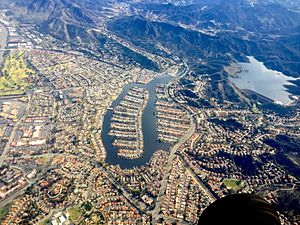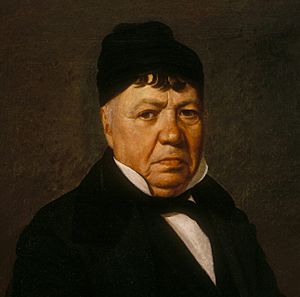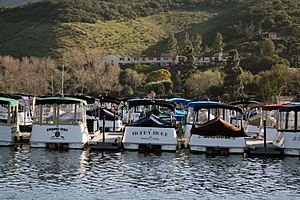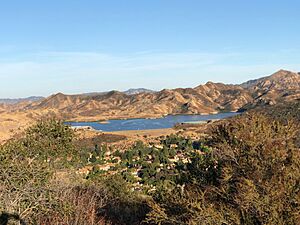Westlake Village, California facts for kids
Quick facts for kids
Westlake Village, California
|
|
|---|---|

Aerial view of the Westlake subdivision
|
|

Location of Westlake Village in Los Angeles County
|
|
| Country | United States |
| State | California |
| County | Los Angeles |
| Region | Conejo Valley |
| Incorporated (city) | December 11, 1981 |
| Government | |
| • Type | Council-Manager |
| Area | |
| • Total | 5.51 sq mi (14.26 km2) |
| • Land | 5.19 sq mi (13.43 km2) |
| • Water | 0.32 sq mi (0.83 km2) 5.80% |
| Elevation | 880 ft (268 m) |
| Population
(2020)
|
|
| • Total | 8,029 |
| • Density | 1,457.2/sq mi (563.04/km2) |
| Time zone | UTC-8 (PST) |
| • Summer (DST) | UTC-7 (PDT) |
| ZIP Code |
91359, 91361, 91362
|
| Area code | 747/818 |
| FIPS code | 06-84438 |
Westlake Village is a city in Los Angeles County, California. It sits right on the edge of Los Angeles County, next to Ventura County. In 1981, Westlake Village officially became a city. It was the 82nd city to join Los Angeles County. In 2020, about 8,029 people lived there.
The city gets its name from the large community built around Westlake Lake. This community is special because it's split between two counties. The lake is right in the middle. Most of the community is actually in the city of Thousand Oaks, which is in Ventura County.
Contents
Exploring Westlake Village's Past
Early Inhabitants: The Chumash People
About 3,000 years ago, the Chumash moved into this area. They lived by hunting animals like rabbits and gathering grains and acorns. We know a lot about their lives from old digging sites and rock paintings. These show how organized and complex the ancient Chumash world was.
A Chumash village called Hipuc was here around 500 BCE. The Chumash collected acorns and other seeds in the fall. They also hunted wild animals and fished. Their diet included gophers, rabbits, skunks, and rats. They made clothes from animal skins. Women wore skirts made of grass or bark. Men wore deerskin around their waists. Both men and women painted their bodies and wore shell beads.
First European Encounters
In January 1770, a group of Europeans led by Gaspar de Portolá explored the area. They were likely the first Europeans to meet the Chumash in the Conejo Valley. Father Juan Crespí, who wrote about the trip, described a Chumash village called El Triumfo. He noted that the village had plenty of water and wood. He also said the land was full of pastures and oak trees. Crespí named the spot El triunfo del Dulcísimo Nombre de Jesús, meaning The Triumph of the Sweetest Name of Jesus.
Other Chumash villages were found nearby. These include Satwiwa and two villages near Newbury Park. Archeologists believe these villages were settled over 2,000 years ago. Another village was located near Lake Sherwood.
Ranches and Movie Sets
In 1795, this land became part of Rancho Simi, one of the first Spanish land grants. It was given to the Pico family. When Mexico became independent in 1821, California became Mexican territory. The Rancho Simi grant was confirmed in 1842.
In 1881, the Russell brothers bought a large part of the land. They used it for cattle ranching. The area was known as the Russell Ranch for a long time. Later, in 1925, William Randolph Hearst bought it. Then, in 1943, Fred Albertson bought it. The Russell family still leased some land for their cattle. The Albertson Company used the huge area as a movie ranch. Many movies and TV shows were filmed here. These include Robin Hood, King Rat, and episodes of Tarzan and Bonanza. The 1940 film Danger Ahead was filmed on Westlake Boulevard.
Building a Planned Community
In 1963, the American-Hawaiian Steamship Company bought the 12,000-acre ranch. They paid $32 million for it. They worked with Prudential Insurance Company to plan a new community. This plan was for a "city in the country." It would have shops, homes, and lots of green space. The lake would be the main feature. Many experts helped design this new community. It became a great example of 1960s suburbanism.
The original land was split by the Los Angeles and Ventura county line. In 1968 and 1972, parts of the Westlake development in Ventura County joined the city of Thousand Oaks. Then, in 1981, the Los Angeles County part of Westlake became its own city. This is the City of Westlake Village. California law does not allow a city to be in two different counties.
Geography and Natural Beauty
Westlake Village is a "bedroom community" for Los Angeles. This means many people live here and work in Los Angeles. It also has many large offices. Companies like the Dole Food Company, K-Swiss, and J.D. Power and Associates have their main offices here. Major roads like the Ventura (101) Freeway are nearby. It's also a short drive to the mall in Thousand Oaks.
Much of Westlake Village is surrounded by open spaces. These areas have trails for hiking, biking, and horse riding. The huge Santa Monica Mountains National Recreation Area is also close by. The town is in the northwestern part of the Santa Monica Mountains. It is about 9 miles (14 km) from the Pacific Ocean. This area is a wildlife corridor, which helps animals move between different natural habitats. Mountain lions have even been seen in the neighborhoods. The lake's water flows into Malibu Creek.
The area has several golf courses. These include the Westlake Golf Course, Sherwood Country Club, and North Ranch Country Club.
More than half of the original "Westlake" development is in Ventura County. This part is within the city limits of Thousand Oaks. The line between Westlake Village and Thousand Oaks goes right through the Westlake Golf Course and half of the lake. Lake Sherwood is also nearby.
Westlake Village is about 40 miles (64 km) west of downtown Los Angeles. It is in the Conejo Valley. Other nearby communities include Thousand Oaks, Oak Park, Agoura Hills, Calabasas, Newbury Park, and Malibu.
Climate in Westlake Village
Coastal breezes blow through the canyons here. This means Westlake can be about 10 degrees Fahrenheit (5.5 degrees Celsius) cooler than the nearby San Fernando Valley in summer. It also has less haze. However, it is usually 10 degrees hotter than the coastal areas like Camarillo and Ventura.
Who Lives in Westlake Village?
| Historical population | |||
|---|---|---|---|
| Census | Pop. | %± | |
| 1990 | 7,455 | — | |
| 2000 | 8,368 | 12.2% | |
| 2010 | 8,270 | −1.2% | |
| 2020 | 8,029 | −2.9% | |
| U.S. Decennial Census | |||
In 2010, the part of Westlake Village in Los Angeles County had 8,270 people. Most residents were white. There were also many Asian, African American, and Hispanic or Latino people. About 21% of the population was under 18 years old. The average age was about 48.7 years. Most people lived in homes they owned.
In 2000, there were 8,469 people living in the city. The average household income was high, showing that many families in Westlake Village are well-off.
Economy and Jobs
Dole Food Company has its main office in Westlake Village. In 1994, Dole decided to build its world headquarters here. Other companies like K-Swiss, Guitar Center, and PennyMac Loan Services also have their headquarters in Westlake Village.
Top Employers in Westlake Village
Here are some of the biggest employers in the city, based on a 2020 report:
| # | Employer | # of Employees |
|---|---|---|
| 1 | Bank of America | 1,150 |
| 2 | Four Seasons Hotel | 500 |
| 3 | Move Inc. | 300 |
| 4 | iPayment | 300 |
| 5 | Costco | 275 |
| 6 | Oaks Christian School | 250 |
| 7 | Conversant | 225 |
| 8 | Target | 200 |
| 9 | Warner Pacific Insurance | 175 |
| 10 | Call Source | 150 |
Parks and Fun Activities
Right next to Westlake Village is the Santa Monica Mountains National Recreation Area. This huge park has nature trails for everyone. You can hike, backpack, mountain bike, or ride horses. It's also a great place for picnics and camping.
Here are some of the parks in Westlake Village:
- Berniece Bennett
- Canyon Oaks
- Foxfield
- Russell Ranch
- Three Springs
- Triunfo Creek Park
- Westlake Village Community Park
- Westlake Village Dog Park
Schools and Learning
Most of Westlake Village in Los Angeles County is part of the Las Virgenes Unified School District (LVUSD). Students usually go to White Oak Elementary School in Westlake Village. Then they go to Lindero Canyon Middle School and Agoura High School, both in Agoura Hills.
A small part of the city in the south is in the Santa Monica–Malibu Unified School District.
The part of Westlake Village that is in Ventura County (part of Thousand Oaks) is in the Conejo Valley Unified School District.
California Lutheran University also has a center nearby in Thousand Oaks.
City Services
The Las Virgenes Municipal Water District provides water services to homes and businesses in Westlake Village. They handle drinking water, recycled water, and wastewater.
Famous People from Westlake Village
- David Anderson, football player
- James Caviezel, actor
- Bob Chapek, former CEO of The Walt Disney Company
- Jimmy Clausen, football quarterback
- Lenny Dykstra, baseball player
- Wayne Gretzky, famous hockey player
- Audley Harrison, Olympic boxing champion
- Mariel Hemingway, actress
- Hulk Hogan, pro wrestler and actor
- Cobi Jones, soccer player
- Kathryn Joosten, actress
- Hayley Kiyoko, singer and actress
- Martin Lawrence, comedian and actor
- Mike Lieberthal, baseball catcher
- Jonathan Lipnicki, actor
- Heather Locklear, actress
- Maureen McCormick, actress (Marcia Brady from The Brady Bunch)
- Joe Montana, Hall of Fame football quarterback
- Eddie Money, musician
- Dian Parkinson, model and TV personality
- John Ratzenberger, actor (Cliff Clavin from Cheers)
- Kim Richards, actress and TV personality
- Mickey Rooney, actor
- Bas Rutten, mixed martial arts fighter and actor
- Mike Scioscia, baseball player and manager
- George C. Scott, actor
- Vin Scully, voice of the Los Angeles Dodgers
- Will Smith, musician and actor
- Robert Stock, baseball player
- Tommy Thayer, KISS lead guitarist
- Guillermo del Toro, film director
- Jered Weaver, baseball pitcher
- Peter Weber, TV personality
- Eric Wynalda, soccer player
- Christian Yelich, baseball player
- Robert Young, actor
See also
 In Spanish: Westlake Village para niños
In Spanish: Westlake Village para niños






